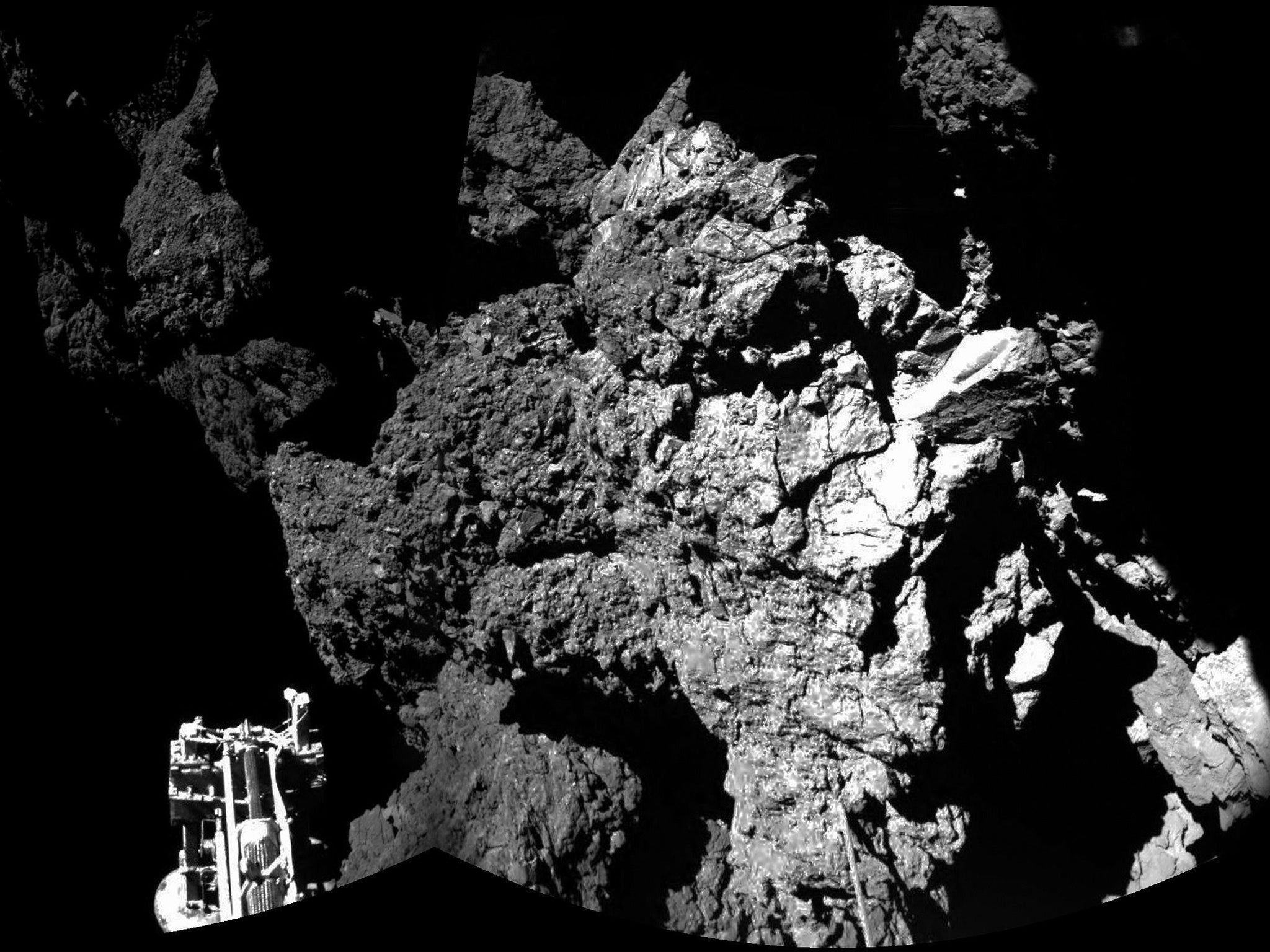Rosetta: Philae probe lands in the shade – prompting fears over battery life
Rosetta's lead scientist: "What is really amazing is not the degree of failure but the degree of success"

European space engineers are hoping to carry out carefully programmed manoeuvres over the coming hours and days to rescue the Philae lander from its precarious position on the comet 67P/Churyumov-Gerasimenko after it unexpectedly bounced twice on landing.
The fridge-size lander is standing on two of its three legs, and its solar panels are sitting in the shadow of a nearby cliff face forming the edge of a large crater where Philae was supposed to have made a soft touch-down on the comet, the European Space Agency (ESA) said.
The orbiting Rosetta spacecraft was tonight trying to work out exactly where its Philae lander is located. ESA scientists calculated that Philae’s first bounce, lasting nearly two hours, carried it about a kilometre away from the original point of contact while the second smaller bounce lasted for about seven minutes, carrying it several metres further.
It finally came to rest under the influence to the comet’s exceptionally low gravity, which is just one hundred-thousandth of the Earth’s gravitational force, meaning that the lander weighs about a gram on the comet.
The primary batteries are expected to run out of power within the next two to three days as Philae had enough on-board battery power to last about 64 hours from the time of landing. Ground engineers are analysing whether it might be possible to adjust its solar panels, which are wrapped around the lander’s body, to extend Philae’s working life.
Almost all of Philae’s instruments are working well and ESA scientists said that the Rosetta mission has already accumulated more data on a single comet than any previous space mission, despite the less-than-perfect landing.
However, the precarious landing means that a plan to drill into the comet may have to be postponed indefinitely because of the risk of destabilising the lander.
Rosetta is the first mission to orbit a comet and the first to land a robotic probe on its icy surface. It took 10 years since its launch in 2004 for Rosetta to travel to comet 67/P, which currently 510m km (311m miles) from Earth in the direction of the constellation Sagittarius.
“Do not have the impression this is a failure. What is really amazing is not the degree of failure but the degree of success. It’s gorgeous where we are,” said Professor Jean-Pierre Bibring, the lead landing scientist on Rosetta.
“We are just in the shadow of a cliff. We are in a shadow permanently, and that is part of the problem,” Professor Bibring said from ESA’s mission control in Darmstadt, Germany.
READ MORE: WHY DID PHILAE BOUNCE?
Professor's reaction is a scientifically accurate picture of joy
Philae sends back first ever image from comet 67P
“We're almost vertical. One foot probably is in open space and two feet are on the surface. It could be that we are somewhere in the rim of this crater, which could explain this bizarre orientation,” he said pointing to an image of the landing crater on the comet’s smaller lobe.
“[Still] many of the other instruments have already acquired what they wanted to. A lot of science is getting covered now. We might try to better orientate the solar panels,” he added.
If the solar panels were working at full throttle, the Philae lander could still be collecting and transmitting data through to next March, when the surface temperatures are expected to become too high for its instruments to function.
Click to enlarge graphic
It may still be possible to perform some manoeuvres that could bounce the lander back into the sunlight, but ESA is unlikely to take this risk unless there is nothing to lose in terms of gathering further data.
It is also possible that as the comet moves closer to the Sun, and angle of sunlight might change, bringing Philae out of the shadow. If this happens, the batteries, which are designed to go into “hibernation”, might start to recharge themselves and so trigger a second contact with the Rosetta mothership overhead.
But even if the Philae lander runs out of power within the next few days, the Rosetta spacecraft will continue to orbit the comet as it makes its closest approach to the Sun, sending back images and data for another 12 months, ESA said.
What has Philae found so far?
Masses of information has already been gathered on the comet 67/P and the data could help to solve some of the biggest questions in space, such as whether comets could have brought water and the simple organic building blocks of life to the early Earth.
“Rosetta is trying to answer the very big questions about the history of our Solar System. What were the conditions like at its infancy and how did it evolve? What role did comets play in this evolution? How do comets work?” said Matt Taylor, the London-born project scientist on Rosetta.
While the Philae lander gathers data from the surface of the comet, the orbiting Rosetta mother-ship will collect information and images from above – for the next 12 months as the comet makes its closest approach to the Sun.
The lander has already measured the electrical, mechanical and magnetic properties of the surface and is probing the comet’s internal structure with low-frequency signals sent to Rosetta when it dips below the horizon.
Join our commenting forum
Join thought-provoking conversations, follow other Independent readers and see their replies
Comments
Bookmark popover
Removed from bookmarks